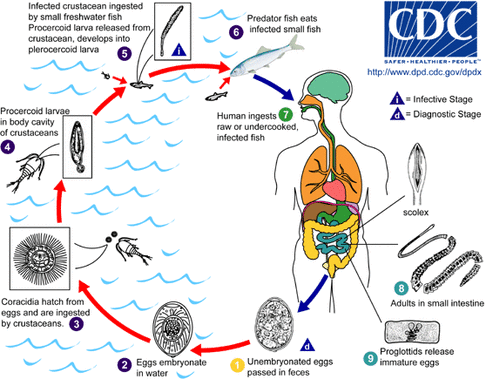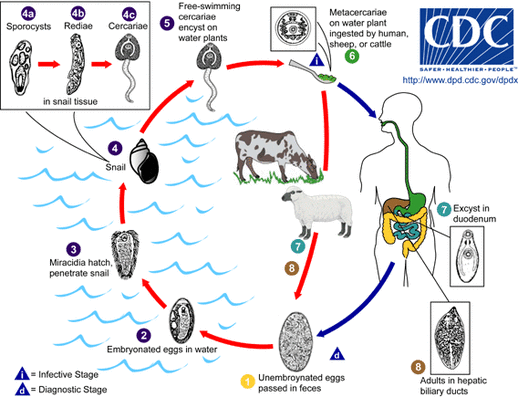Resources:
Background information on Platyhelminthes:
- Introduction of Platyhelminthes from the University of California at Berkley
- Platyhelminthes resource page from Discoverlife.org
- Platyhelminthes resource page from Animal Diversity Web
- Platyhelminthes resource page from Encyclopedia of Life
Research
- Parasitic flatworms associated with eating raw seafood
This is a 2009 study that investigated the incidence of a parasitic flatworm (tapeworm) that you can get from eating raw seafood.
Diphyllobothriasis Associated with Eating Raw Pacific Salmon
Parasitic Life cycles

Diphyllobothriasis Tapeworm Life Cycle:
- Eggs are passed out of an infected human through feces
- Eggs become embryonated in the water
- Host 1:
Coracidia hatch from eggs and are ingested by a crustacean - Procercoid larvae of the tapeworm enters the body cavity of the crustacean
- Host 2:
The infected crustacean is consumed by a fish and the procercoid larvae are released from the crustacean and develop into plerocercoid larvae - Host 3:
A larger predatory fish eats the smaller infected fish and becomes infected - Host 4:
Humans eat raw or undercooked infected fish and develop in the small intestine.

Fascioliasis fluke life cycle
- Infected mammal (cattle, sheep, or human) releases eggs into the water via feces
- Unembroynated eggs develop into embryonated eggs in the water and hatch into miracidia
- The miracidia infects a snail and within the snail tissue the fluke passes through the following three stages: i) sporocysts, ii) rediae, and iii) cercariae
- The cercariae swims out of the snail and develops into a metacercariae on a water plant where it infects a mammal (cattle, sheep, human) when the plant material is consumed.
